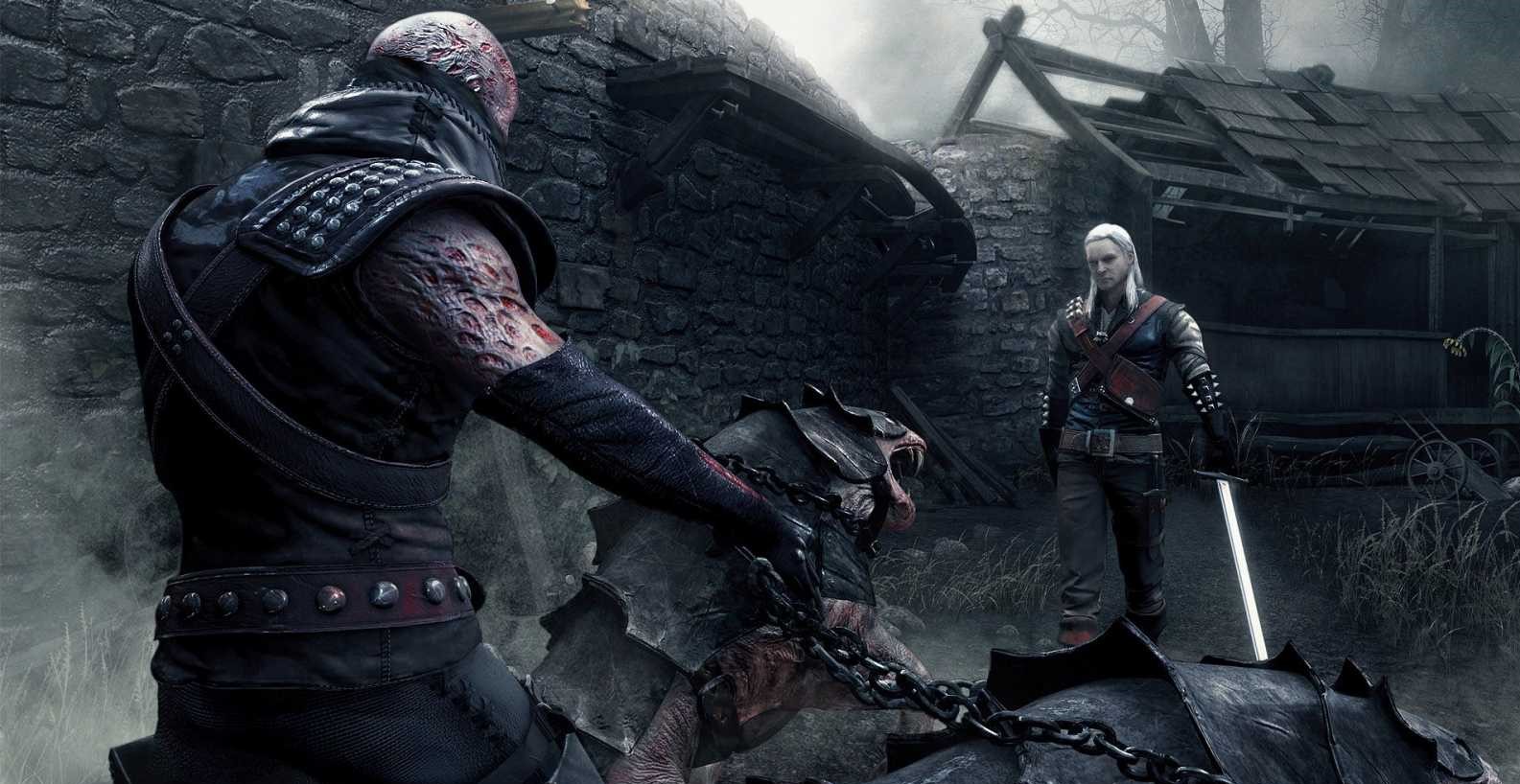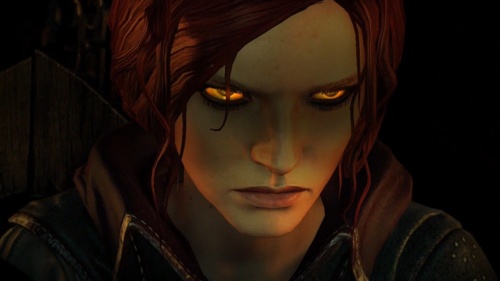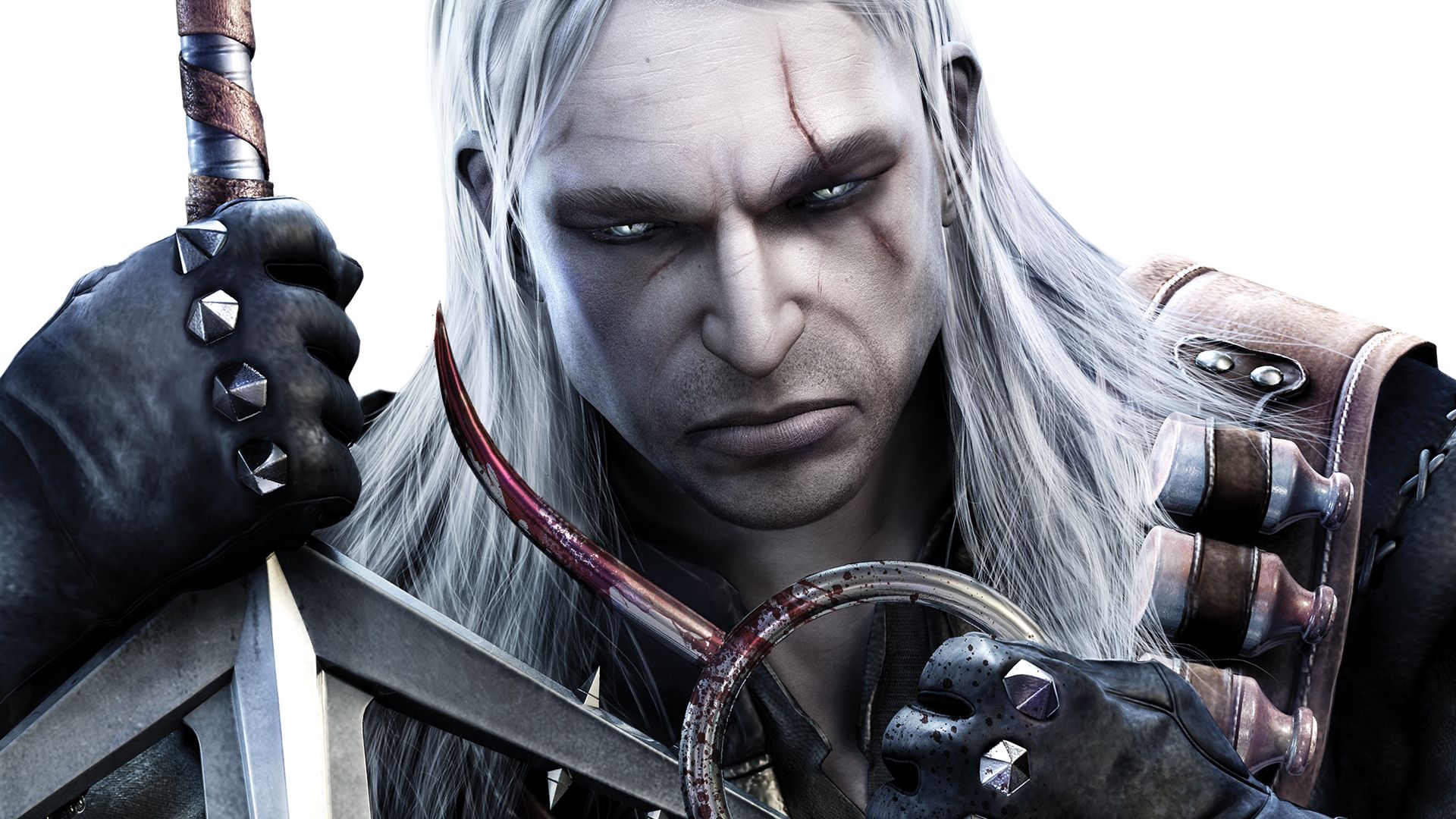Geralt of Rivia. Mercenary. Witcher. Made and trained to kill monsters in the defence of humankind as a sword for hire, he wanders from town to village to smallholdings in the countryside seeking notices nailed to bulletin boards and fence posts. Or maybe the sound of screams from somewhere deep inside the forest nearby, heralding potential work for his kind that they might fill their coin pouch. Drowners, manticores, vampires, kikkimoras, anything the local alderman might pay a bounty for. His downtime is spent playing dice or cards, or brewing potions for his work and tending to his injuries while enjoying the company of a beautiful woman.
Geralt’s adventures were first published in book form by Polish author, Andrzej Sapkowski, as a series of short stories depicting the Witcher’s various jobs ranging from slaying a beast preying on local merchants along the road to lifting curses from a princess at the personal behest of the King. Through all of this, he endures the adulation of those he saved in equal measure to the animosity from those who scorn his kind. Witchers are not quite human, you see. They are usually taken as children to a Witcher fortress that acts as their school, taught to fight with swords, practice herblore for potion brewing, given training in tracking animals, anything that their work would require. Once they come of age, and only if they survive, they are put through the Trial of grasses where their young bodies are subjected to powerful mutagen potions, one after the other, and infected with various sicknesses to develop immunity that will last a lifetime to all sickness. Spells are cast to inject a little magic into them, though just a little.
The books set out a world that is rich and well developed, so it is hardly a surprise that the games that followed would have a good start with such a well-developed backstory to lean comfortably on like a pile of cushions. Unlike other game developers, CD Projekt Red did not set The Witcher directly in and among the existing books from the 1990’s. They took the bold move to set their game in the events after the last books and continue telling the story of Geralt in their own original adventures.
The game is now a huge trilogy, and I finally decided to dive into them after owning the first two games for a good couple of years after buying them as part of a Steam sale. And this time, to spur me on even more, I streamed the games on my channel on Twitch. Having experienced all three now, I want to put some thoughts down on each game and the franchise as a whole.
I had played the first Witcher game briefly about a year ago, before I started streaming, and was mostly put off by the control systems than anything else. Not just the movement but also the combat style. The camera seemed to float around behind Geralt as though playing a classic RPG in isometric, though you could free rotate and tilt the camera. The problem was the camera would not follow Geralt’s direction of travel and you needed to keep adjusting it like a stubborn picture on the wall that refuses to stay level. Movement could be done with both keyboard and mouse click, again feeling like a strange hybrid of an old RPG and a third-person action game. As for the combat, well it felt kind of disconnected as one-click would activate several pre-animated swings in a neatly choreographed sequence. As the final blow lands, your only job is to click the cursor on the enemy a second time when it shows a flaming sword icon, causing Geralt to follow up with a second phase attack of even more elaborate twirls and thrusts. A third and final timed attack will deal major damage to the enemy and then, if it still stands, you start at phase one again by building up your attacks.
This might not sound like much, and in truth I was originally neither enthused nor put off by the style of attacking. On my second playthrough while streaming the game, I began to appreciate the reasons for this. The combat system as a whole is designed entirely with the unique fighting style of a Witcher in mind. Their movements are fluid, their armour is lighter studded leather, and their attacks are fast and precise. In short, the system is more a showcase for this than an involved system and gives you time to appreciate the fighting form of Geralt. Your job as the player is to give him a little nudge every now and then to remind him he is still meant to be attacking the poison-drooling corpse eater in front of him.
Even with this system there are tactics you must learn. Firstly, Geralt has two swords; one of iron, one of silver. The silver sword is for monsters, the iron for everything else. You must switch between them in combat as best favours your enemy type, and then there is the matter of combat style. Geralt has three distinct forms of swordplay for each weapon. One is a fast style, useful for faster and smaller enemies. Different beasts and men alike have their own fixed way of fighting, though I find some can swap between fast and heavy attacks so you have to adapt too. The second is Geralt’s own heavy attack style. Finally, he has a group combat form for when he is surrounded. Once three or more enemies surround Geralt the ideal counter-style to their kind is no longer as effective and instead he must attack and defend from all sides. You will also find yourself fighting a mix of not only fast and heavy enemies but also monster and non-monster enemies, so keeping an eye on your sword type and style is essential and you will learn to prioritise threats over time. (And many, many deaths).
With regards to the group style, I feel the game did not do as well of a job explaining its function during the combat introduction and, instead, led me to believe this style was for when fighting with an NPC ally of some kind. I spent most of the first half of the game running around in circles waiting for my health to recover, a conga line of angry monsters or bandits following along around the base of a tree. The first time I switched to this style by accident, the light bulb popped up over my head with a proverbial ‘ding‘. Geralt started damaging all enemies at once while taking less or even no damage at all, meanwhile the enemy I was clicking on started finally taking hits again. Another aspect that was not explained, being that enemies in a group get a defensive advantage from their allies around them.
‘Ohhhhhhhh…’ said I to my audience. Oh well, you live and learn.
Other things you need to do regular is to brew potions, meaning herb gathering in the wild should become second nature. You also need to keep your sword sharp with whetstones, and oiled with the correct kind of venom for the enemies you will be fighting. All of these things will give you an edge in the unforgiving dark fantasy world of The Witcher.
 As I have also said before, The Witcher enjoys a deep and well-fleshed-out world already envisioned by the author of the original novels. The story of the games keeps itself true to form setting wise, where the bywords are political intrigue and moral ambiguity. You will have to make choices in the story and side missions. Do you kill someone or something, or spare their lives? Do you assume the shady gang leader in the slums of Visima is in league with your main enemy, or are they too embattled against them and this is simply dark alley politics and posturing? The consequences are not always as simple as ‘I fight a thing or I don’t’ as making the wrong choice could also cost you in the long run in the form of support from other characters.
As I have also said before, The Witcher enjoys a deep and well-fleshed-out world already envisioned by the author of the original novels. The story of the games keeps itself true to form setting wise, where the bywords are political intrigue and moral ambiguity. You will have to make choices in the story and side missions. Do you kill someone or something, or spare their lives? Do you assume the shady gang leader in the slums of Visima is in league with your main enemy, or are they too embattled against them and this is simply dark alley politics and posturing? The consequences are not always as simple as ‘I fight a thing or I don’t’ as making the wrong choice could also cost you in the long run in the form of support from other characters.
One key part of the story will try and trip you up if you rush in too fast and trust one character too readily. If you don’t pay attention you will unwittingly help your enemy as he sabotages your investigation into the events of the beginning of the story. In short, the Witcher fortress is attacked by a band of mercenaries, their prized mutagen formulas are stolen, and a gang of drug dealing human supremacists are involved somehow. You follow their trail through the game and find how deeply entwined they, and their two leaders are in the higher politics of the kingdom of Temeria while attempting to discover their ultimate agenda.
Also, due to the initial plot setting circumstances, Geralt has lost his memory and has to relearn everything he knows in order to do his job. There is an active knowledge system in the game that will help Geralt fulfill his contracts. When you go to a town, you will find contracts for various beasts in the world. They almost always require proof of the deed in the form of a trophy, another thing that Witchers do in the novels that has been faithfully represented in the game. Geralt cannot get these specific trophies unless he has academic knowledge of the beast in question. And without having read a book about that specific monster type, there is no way that Geralt would know how to remove the skull from a Barghest, or cut the tongue from a Drowner.
This is where I feel the setting is stretching itself somewhat into the territory of catering to this being a video game and, as we all know, that is what games do. Got to collect those pelts from wolves and wings from bats for some nebulous reason. Compared to the third game in the series, which makes more of an effort to weave the monster hunts into a more involved and unique narrative, the majority of contracts that act as filler activities make little sense from a lore point of view. An inn-keeper, for example, may ask Geralt to clear out a cave nearby since it is overrun with demon dogs. In order to prove the job is done, Geralt must bring back a collection of trophies. But rather than just the head of the beast, easily identifiable to your average run-of-the-mill tavern owner, he wants their brains. Because of course he would know what they look like. Yeah… it feels a bit contrived but it does not obstruct the main meat of the game. It simply acts as a gate to completing the quest, requiring the player to have Geralt learn about these dogs so he knows how to remove their brains. As i said, it is a game being a game.
It is not all contrived, though. An alchemist wants specific parts from a monster for potion work and maybe the Druids in the swamp want wolf teeth to make necklaces to sell to tourists or the like. So it is not all ‘Wyverns killed my sheep after they moved onto yonder hill, please oh great Witcher, go slay them. I want you to bring me their livers as proof of the deed. Ten should do it, I think.’ I think that Mr Farmer simply wants in on the lucrative organic Wyvern liver market, though I understand because I also hear they are pretty tasty fried up with some onions and served with turnips. Perfect for those cold Temerian autumn nights.
Overall, these minor complaints aside, I am glad I played the game. Being an older game shows in more ways than the publishing date on its Steam store page, but it does not feel too dated as a result. There is replayability as well, as you can choose between straddling the line between human supremacists who call non-human races thieves and terrorists, the Elven freedom fighters leading the charge for the downtrodden by taking hostages in the city, or walk the thin line between where you find out staying neutral is next to impossible if you expect to come out ahead in some way.
I will continue my breakdown of the second and third game in separate blogs, as each of them deserves weighing up in their own right. As a final word on the wider trilogy though, I will say that playing them back to back the way I did served to better highlight how the franchise has evolved as a whole from game to game. Not simply graphically but also in terms of game systems and story presentation.
 On that note, I wanted to save this final point for last so as not to sour impressions on the entire series. The writing in the first game and the second are as stark as night and day with regards to some of the games more brazenly mature areas. Through the course of the first game, the content brashly highlights Geralt’s character as what can be kindly described as a ‘ladies man’. Women, either friends, strangers and even his enemies, throw themselves at him and flirt in a way that is almost jarring, making instant sexual overtures in the middle of basic conversation. One of the first taverns you go to in the story has the barmaid ask him if he wants anything and the conversation options include asking for sex in the back room when she hints at the bed she has back there. Yes, it is simply that easy for the most part. Taken in context of the whole game, almost all occasions for nookie are out of place with the tone of the moment. I described this on my stream as being as if the script had been given to a fourteen-year-old who then handled the ‘romantic’ plotline.
On that note, I wanted to save this final point for last so as not to sour impressions on the entire series. The writing in the first game and the second are as stark as night and day with regards to some of the games more brazenly mature areas. Through the course of the first game, the content brashly highlights Geralt’s character as what can be kindly described as a ‘ladies man’. Women, either friends, strangers and even his enemies, throw themselves at him and flirt in a way that is almost jarring, making instant sexual overtures in the middle of basic conversation. One of the first taverns you go to in the story has the barmaid ask him if he wants anything and the conversation options include asking for sex in the back room when she hints at the bed she has back there. Yes, it is simply that easy for the most part. Taken in context of the whole game, almost all occasions for nookie are out of place with the tone of the moment. I described this on my stream as being as if the script had been given to a fourteen-year-old who then handled the ‘romantic’ plotline.
Thankfully, this is toned down massively in the second and third games without detriment to the ‘Mature’ rating of the game. Sex still exists, and if anything the graphical representation has been dialled way up as the game trades a blurred out scene of writhing, mostly covered over by some kinky artwork of the lucky lady on a playing card, with high resolution fully naked sex scenes that border on pornographic. But more on the other two games in my future blogs.
The sexual side of the game is not a deal-breaker, and players can easily avoid all of this by sticking to the tamer conversation options, though you can carry through your progress to future games and the romantic state of affairs with the cast carry over as well when you import your save to The Witcher 2. Also the other choices you have made will echo in the second game, and by the third you can have entire circumstances change as characters who did not survive to this point are absent from the plot.
If there is anything that The Witcher showed me, it is that it is always worth giving a game the benefit of the doubt despite first impressions. I was glad to have played the whole game if only for the core of the story and the characters themselves who only develop and get better as the series moves along.
